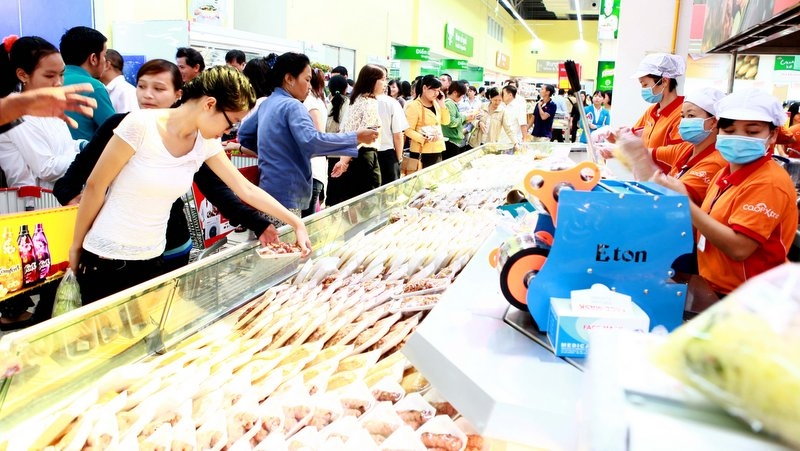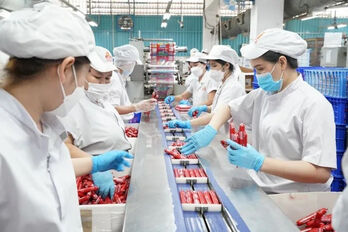
Illustrative image
At present, NTTS Trading JSC is busy making preparations for the expansion of its warehouse system, which is expected to commence operations by the end of this year.
The system, covering more than 6,000 square metres in the northern province of Hung Yen, will be used by the firm to preserve meat and meat-related products imported from Australia and New Zealand.
“We are importing meat and meat-related products from India and the US, and will now expand import markets to Canada, Australia and New Zealand,” said the firm’s vice director Nguyen Thi Nguyet. “Various types of meat products from these three new markets will enjoy a 0% import tax rate beginning from 2019, under the Comprehensive and Progressive Agreement for Trans-Pacific Partnership (CPTPP).”
For example, Vietnam will have to cut import tariffs for a number of key Canadian husbandry exports, such as beef (tariffs of up to 31% on fresh, chilled and frozen beef will be eliminated within two years, and tariffs of up to 34% on all other beef products will be eliminated within seven years), and pork (tariffs of up to 31% on fresh, chilled, frozen and prepared pork products will be eliminated within nine years).
From 2018, the domestic husbandry sector will face bigger difficulties due to import tariff slashes under several free trade agreements (FTAs), including the CPTPP signed in early this March, the ASEAN Trade in Goods Agreement (ATIGA) and the ASEAN-China Free Trade Agreement (ACFTA).
For example, upon CPTPP’s entry into force, expected to begin in early 2019, import tariffs of many livestock products, such as beef, pork, sheep, goat, poultry, many types of frozen aquatic products, dairy products, animal feed, and poultry eggs, will begin to be gradually reduced to 0% within three or five years.
Products from nations that have strong advantages in husbandry, such as Canada, Japan and Australia, will come to Vietnam in great numbers. This will have negative impacts on the domestic livestock production, according to the Ministry of Agriculture and Rural Development’s Livestock Production Department.
Furthermore, after the CPTPP becomes valid, all products with registered national brand names will also be allowed to be exported to all CPTPP countries without any quotas, providing they meet the importing nation’s conditions. Even, not only raw products, but also finished products from CPTPP markets will be able to be imported into Vietnam.
According to the Ministry of Industry and Trade, under its commitments this year, Vietnam will have to remove the remaining 669 tariff lines under ATIGA, and 588 tariff lines under ACFTA. In which the average import tariffs for livestock-related products will almost be reduced to 0%.
Under the ASEAN Economic Community (AEC), ACFTA, and CPTPP, enterprises and investors may concentrate production lines in a chosen partner country, and then export finished products tariff-free to other member countries, as well as to ASEAN’s free-trade partners in the region (Australia, China, India, Japan, New Zealand, and South Korea).
According to a recent survey by the Vietnam Institute for Economic and Policy Research on the impacts of the AEC on Vietnam’s livestock sector, local livestock production would drop because of harsh competition from AEC partners.
The survey revealed that within the AEC, tariff cuts by Vietnam in the husbandry sector would negatively affect the total production value of the sector mainly because of higher competition from imported goods.
Besides, animal, meat and dairy products are the most affected by tariff cuts, among the livestock sub-sectors. Once the tariffs are removed by the AEC, substitutions for cheaper imports of meat products reduces the demand for domestically produced meat products, and this effect is projected to result in a US$107 million loss for the livestock sector.
Under the impacts of AEC tax slashes, livestock exports, mainly in swine meat and poultry, from Vietnam to other ASEAN countries are forecast to decline. Reductions of 82% to Thailand, 7% to the Philippines, and 3% to Indonesia are expected.
At present, Vietnam is importing meat and meat-related products from many foreign markets, including Australia, Canada, China, India, New Zealand, and the US. Vietnam is also Australia’s second largest importer of live cattle and wheat.
In 2017, Vietnam-based enterprises spent nearly US$500 million importing assorted types of meat, including over 6,500 tonnes of pork worth nearly US$12 million, and over 81,000 tonnes of poultry meat worth nearly US$76 million.
Moreover, last year, the enterprises also imported more than 262,300 live cattle, and nearly 420,000 tonnes of beef and buffalo meat, worth a total of US$410 million./.
NDO
 Vietnam on track to rank among world’s 30 largest economies
Vietnam on track to rank among world’s 30 largest economies



